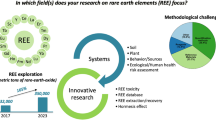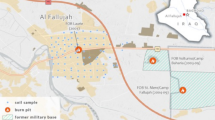Abstract
An urgent environmental problem in the Perm region is the increased concentration of some heavy metals in soils. This paper presents the results of studying the ecological and geochemical role of the magnetic fraction of soils in the Middle Cis-Urals. The study used magnetometry, geostatistical and geochemistry methods. It has been established that the magnetic fraction is a geochemical barrier in soils and accumulates potentially toxic elements (Mn, Ni, Cu, Co, and Pb). The total content of Mn, Zn, Ni, Cu, Co, and Pb in the soils of the agricultural landscapes of the taiga-forest zone of the Middle Cis-Urals exceeds the clarke of world soils. The ecological-magnetic subprofile of the studied soils is subdivided into ecological-magnetic layers: accumulation, destruction, and stable state of magnetic particles. The environmental organizations of the Perm region are recommended to use methods of ecological magnetism for carrying out soil-ecological monitoring and identifying land contaminated with heavy metals. The obtained information about the elemental chemical composition of soils of the Middle Cis-Urals can be used in the management of land resources and the development of the concept of land policy in the region.




Similar content being viewed by others
REFERENCES
A. F. Vadyunina and V. F. Babanin, “Magnetic susceptibility of some USSR soils,” Pochvovedenie 10, 55–66 (1972).
A. P. Vinogradov, Geochemistry of Rare and Trace Chemical Elements in Soils (Acad. Sci. USSR, Moscow, 1957) [in Russian].
Y. N. Vodyanitskii, Soil Pollution with Heavy Metals and Metalloids and Their Environmental Hazard (Analytical Review) (Moscow State Univ., Moscow, 2017) [in Russian].
T. V. Vologzhanina, M. V. Moskvitin, and V. F. Butenko, “Soil-geographical zoning and structure of the soil cover of the Perm region,” in Scientific Bases for Improving Soil Fertility: Interuniversity Collection of Scientific Papers (1982), pp. 3–8 [in Russian].
N. F. Ganzhara, B. A. Borisov, and R. F. Baibekov, Workshop on Soil Science (LLC Reart, Moscow, 2017) [in Russian].
S. M. Gorokhova and A. A. Vasiliev, “Ecological and geochemical assessment of the content of chemical elements and features of their spatial distribution in Fe nodules of soils in the Middle CisUrals,” AgroEcoInfo 1, 1–23 (2022). https://doi.org/10.51419/2021211140
Soil Map of the Perm Region (1989), scale 1 : 700 000.
I. S. Kopylov, Geoecology, Hydrogeology and Engineering Geology of the Perm Region (Perm State Univ., Perm, 2021) [in Russian].
G. A. Teplaya, “Heavy metals as a factor in environmental pollution (review),” Astrakhan Bull. Ecol. Educ. 1 (23), 182–192 (2013)
M. M. Tryastsin and V. G. Berlizova, “Effect of the environmental state of soils on land rent in Perm krai,” Plodorodie 6, 43–45 (2010).
Geological Map of the Perm Region (2019), scale 1 : 2 000 000.
IUSS Working Group WRB, World Reference Base for Soil Resources 2014, International Soil Classification System for Naming Soils and Creating Legends for Soil Maps, World Soil Resources Reports No. 106 (UN FAO, Rome, 2015).
S. Lu, S. Bai, and Q. Xue, “Magnetic properties as indicators of heavy metals pollution in urban topsoils: a case study from the city of Luoyang, China,” Geophys. J. Int. 2 (171), 568–580 (2007). https://doi.org/10.1111/j.1365-246X.2007.03545.x
J. Świdwa-Urbańska and J. Batlle-Sales, “Data quality oriented procedure, for detailed mapping of heavy metals in urban topsoil as an approach to human health risk assessment,” J. Environ. Manage. 295, 113019 (2021). https://doi.org/10.1016/j.jenvman.2021.113019
A. Vasiliev, S. Gorokhova, and M. Razinsky, “Technogenic magnetic particles in soils and ecological-geochemical assessment of the soil cover of an industrial city in the Ural, Russia,” Geosciences 11 (10), 1–35 (2020). https://doi.org/10.3390/geosciences10110443
A. Vasiliev, M. Razinsky, and S. Gorokhova, “Application of magnetic susceptibility measurement for mapping and assessment of ecological quality in urban topsoils,” InterCarto.InterGIS 2 (28), 913–925 (2022). https://doi.org/10.35595/2414-9179-2022-2-28-913-925
SanPiN 1.2.3685-21, Sanitary Rules and Regulations. Hygienic Standards and Requirements for Ensuring the Safety and (or) Harmlessness of Environmental Factors for Humans (Federal Service for Supervision of Consumer Rights Protection and Human Welfare, Moscow, 2021).
ACKNOWLEDGMENTS
The authors are grateful to the Russian Foundation for Basic Research for support of the study; the anonymous reviewers of the manuscript for their valuable comments and suggestions that contributed to its improvement.
Funding
The reported study was funded by Russian Foundation for Basic Research, project number 19-34-90070 “Assessment and measures to reduce the environmental risks of soil contamination with heavy metals in the composition of magnetic particles in the management of agricultural enterprises in areas with a high level of anthropogenic pressure on the environment and soil cover”.
Author information
Authors and Affiliations
Corresponding author
Ethics declarations
The authors declare no conflict of interest.
Additional information
Publisher’s Note.
Pleiades Publishing remains neutral with regard to jurisdictional claims in published maps and institutional affiliations.
Supplementary Information
The work is published based on the results of the International scientific conference XXVI Dokuchaev conference for young scientists “Matrix of Soil Science”. http://www.dokuchaevskie.ru.
Rights and permissions
About this article
Cite this article
Gorokhova, S.M., Vasiliev, A.A. & Shchurenko, N.M. Ecological-Geochemical Role of Magnetic Fraction of Soils of the Middle Cis-Urals. Eurasian Soil Sc. 56 (Suppl 2), S161–S171 (2023). https://doi.org/10.1134/S1064229323601579
Received:
Revised:
Accepted:
Published:
Issue Date:
DOI: https://doi.org/10.1134/S1064229323601579




